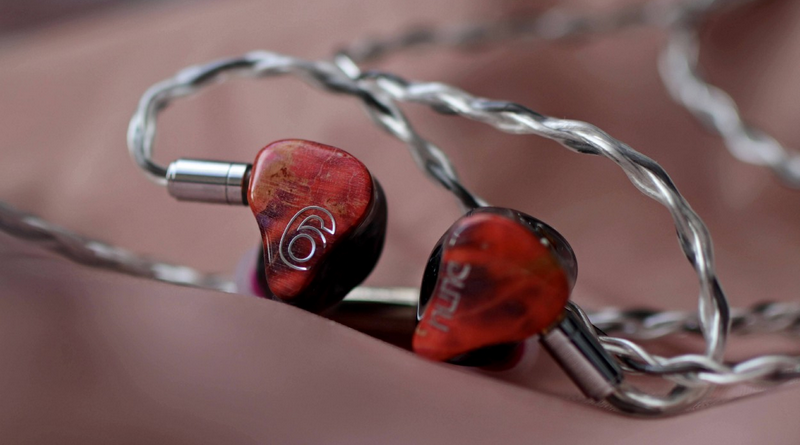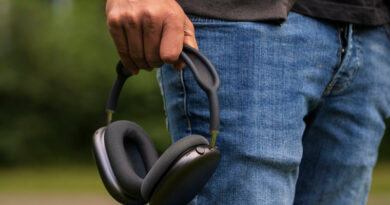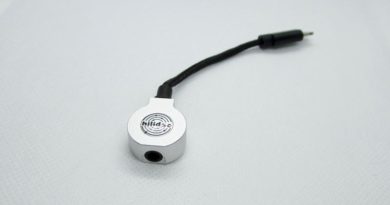Dunu Studio SA6 Review – Special Generalist
Pros — Brilliant tuning overall, smooth yet engaging
– Fantastic design, impeccable UV-cured resin shells
– Comfortable, snug fit
– Class-leading accessories that put many TOTL IEM packaging to shame
– BA bass that doesn’t sound bad
– Resolution that belies the price-tag, great microdynamics
Cons — Stock cable can be a bit heavy for some
– Not as good in macrodynamics as some single-DD/hybrid IEMs in this range
– BA bass is still BA bass, subtle BA timbre in the high notes
– Dips at 4KHz and 6KHz might take away the energy of distortion guitars and cymbal hits
– Not the widest staging or the most precise imaging for the price-bracket
INTRODUCTION
It’s hard to stand out in the IEM space lately.
New brands pop up every now and then with claims of performance that far belies their price-tag, having measurement graphs that seem just about perfect, hitting a specific target curve. Driver count that would seem overkill even in $1000+ IEMs just a few years ago.
It’s really hard to stand out.
Dunu, having dealt primarily with single/multi dynamic drivers and hybrid IEMs for the past decade or so decided to move towards multi-BA setup again. Their new Studio series of IEMs are strictly multi-BA setups and have two models for now: SA3 and SA6. The SA6 is the higher-tier model and aims to bridge the gap between kilobuck IEMs and the relatively budget offerings. I’ve been using the Studio SA6 for the past four months (almost) and I believe now I’m ready to share my long-term verdict, i.e. not a rushed review to gather some sweet, sweet SEO.
So, is the DUNU Studio SA6 a stellar showing, or just another also-ran? Read on.
Note: the ratings given will be subjective to the price tier. DUNU-Topsound was kind enough to send a review unit of the Dunu Studio SA6. Disclaimer.
Sources used: Questyle CMA-400i/QP1R, Cowon Plenue R2
Price (while reviewed): $550
PHYSICAL THINGS AND USABILITY
IN THE BOX…
The Dunu Studio SA6 packaging is smaller than expected, as usually products in this price-bracket come with oversized packaging. Despite the below-average sizing it’s chock-full of accessories. First up: the cable, and this is the centerpiece of attraction no doubt. It’s their DUW-03 cable that retails for $200 as of the time of writing. The cable is an 8-core SPC affair, braided in Litz config. The termination is Dunu’s patented “quick-switch” modular plugs where you can easily swap out plugs by pulling at the plug end. It’s also spring-loaded so the mechanism didn’t get loose after multiple swaps. My biggest gripe about the cable is that it’s a bit too solid, a bit too heavy. I’d have preferred a lighter PVC jacket, but then again — heavy duty cables tend to be heavy. As a bonus, you also get two extra terminations: 2.5mm and 4.4mm pentaconn. Nice!
Then we have the case, which has a blue PU leather outer and felt-padded innards. The case has a small compartment for storing the extra terminations and such so that’s a nice touch. Next up: eartips. There are 11 pairs of eartips in total: 3 pairs of black tips, 4 pairs of white tips, and 4 pairs of blue tips. I personally found best results with the white tips but I’d suggest trying them all out.
Finally, you get a cleaning tool and a 6.35mm converter. The only thing missing is a shirt-clip but with a cable this nice I’m willing to ignore that.
5/5
APPEARANCE, HAPTIC, AND BUILD QUALITY
I’ve made a lot of fun of resin shells in the past since most of them are very generic and look shoddy compared to certain stainless steel finishes out there.
The Dunu Studio SA6 manages to make me eat a humble pie.
The quality of the resin itself is immaculate. No bubbles, no grain, no unevenness. Practically flawless in terms of appearance and haptics with UV-curing and an enamel-like finish that doesn’t attract fingerprints. The Studio SA6 looks pristine even after months of use. The faceplate is stabilized wood underneath where each pattern and color-combo is going to be unique for each earpiece. This is a nice perk and so far I’ve liked every single faceplate I’ve seen. Some might want more customization but I like the randomness myself (esp since they all look good to varying degrees). Then again, this is something one gotta decide for themselves.
The nozzle is a bit short and stout but with the eartips on it should fit snugly. There are three bores in the nozzle, each connected to the bass, mid, and high drivers. I’ll discuss further about the driver configuration in the sound section. There is a single vent beside the 2-pin connector (recessed, thankfully) on the underside of the IEMs. This allows the Sonion vented woofers to have greater excursion than a closed design.
Finally you get to see the switch which is quite easy to flick with your fingernails (even when wearing the IEMs). This is a welcome departure from other designs where one requires fiddly SIM-card ejector like tools to toggle the DIP switches.
Overall: fantastic build quality. I can’t find a single flaw or point of contention.
5/5
ERGONOMICS, COMFORT, ISOLATION, AND FIT
Due to its pseudo-custom fit and moderate nozzle length, the Dunu Studio SA6 offers a very snug, stable fit. I’ve worn it for hours and didn’t feel the need to take it out. Isolation is also above-average despite the vent in the housing. However, there can be some pressure-buildup inside the ear while pulling them out so I’d recommend not yanking them out of your ears and taking it slow.
4.5/5
TECH INSIDE
The Dunu Studio SA6, as the name suggest, is a 6-BA setup. Dunu’s website didn’t mention the exact model number of said BAs but the bass drivers are two Knowles 38D1XJ007. This particular model has a very high excursion for a BA driver and also has better textured bass than its Knowles counterparts. In fact, I think this is the only woofer/bass driver manufacturers should use if they want some decent bass response out of an all-BA setup. Moving on, the mid-range driver is an unspecified Knowles model, though I presume it’s a full-range Knowles driver customized to only have responses in the midrange frequencies. Finally, the treble driver is also unspecified but I believe it’s a Knowles SWFK-31736 dual-tweeter.
The tubing and crossover circuit inside is also interesting. Despite only one tuning switch, the circuitry is quite elaborate. The internal wiring is also SPC for those who keep track of these things. Finally, the tubing has similar length for the mid and treble drivers but the one for the Sonion woofers has a longer pathway. I suspect this is to improve bass rumble (apparently increasing tube length for the bass driver can improve bass response). Each tube also houses an acoustic filter to act as dampers.
SOUND
The general sound signature is mostly balanced with a warm, bassy tilt when the switch is put to “on” position. I did all my listening in this mode as the fuller lower-mids sound more natural to me. I won’t call it neutral because the upper-mids are a bit colored than dead-on-neutrality, though that’s not a bad thing in this case.
Sound impressions are made with Final E-type Clear tips and stock cable. The switch was set to on position.
Bass: There usually is a lot of contention regarding BA bass drivers. They lack the excursion, texture, and slam of their DD counterparts but does offer faster transients and nimbleness. That being said, bass without physicality feels undercooked so I myself am not a fan of BA bass.
The Dunu Studio SA6 changes that notion by a margin, though not entirely so. First off, these vented Sonion woofers are superior to the Knowles/unvented bass drivers when it comes to overall physicality and slam. Sudden bass drops have a body that’s missing on most BA-only IEMs. Secondly, there’s actual bass decay which is a bit similar to DD bass unlike the other BA drivers where there is no reverb which leads to a sense of artificiality.
As for the bass itself, there is a noticeable sub-bass emphasis but it doesn’t get into overkill category. The sub-bass frequencies are boosted over the lower-mids by about +5dB which is just about right for me. Many modern IEMs (e.g. ThieAudio Clairvoyance) boosts this region by ~10dB vs the lower mids which gives rise to the “2.1 subwoofer effect” that I personally dislike (sub-bass sounds detached from the rest of the sound). Fortunately the SA6 is rather coherent and the transition from bass to mids is quite even-handed. The mid-bass has slightly thicker notes than neutral which gives more body to snare hits and double-pedals. Flicking the switch to “off” position does thin down the snare hits slightly so if you want a closer to reference representation you can have that as well. In fast flowing bass section there was no smearing at all, though the bass didn’t quite have the same articulation as a good DD, or the scalpel-precision of typical BA drivers.
Where the bass falls short is the texturing and rumble you only find on good quality DD IEMs. Also if you are into super-nimble BA bass then you won’t get that here since the bass has a bit longer decay than typical BA setups.
To summarize: this is perhaps the best BA bass you can get around the price bracket, but still falls short of excellent DD bass. Something’s gotta give.
4/5
Mids: The midrange is where the Dunu Studio SA6 truly shows its prowess. It’s near-immaculate, at least for the genres I listen to/my taste (Rock/Metal/Pop/Singer-songwriter). The biggest issue with the midrange is the slight coloration in the upper-mids that makes higher-pitched vocals sound somewhat strained on some tracks (e.g. Billy Talent’s Surrender), but this is so rare that I’m inclined to blame the mastering for it.
With the switch turned on, the lower-mids are full and provides adequate heft to Baritone vocals, e.g. Colin Hay’s I Just Don’t Think I’ll Ever Get Over You. The upper-mids peak around 2.5KHz and are ~7dB higher than the lower mids and this provides adequate pinna gain without sounding diffused or shouty. At the same time acoustic guitars and guitar riffs get adequate bite. In terms of tuning and tonality — this is pretty much spot on. Another thing of note is the timbre which is quite natural but does exhibit some BA artificiality in cymbal-heavy tracks. The Studio SA6 does keep the timbre fairly natural and that’s commendable given its all-BA nature and how even many higher-tier IEMs ignore the timbral characteristics for sheer technical proficiency.
Beyond the tuning itself, the resolution is very good for the price bracket. You don’t get the macro and microdynamics of higher end IEMs (and that’s likely the biggest weakness of the SA6 if I am to nitpick) but what you get here is again — excellent, if not class-leading for the price bracket.
5/5
Treble: The treble tuning is what I’d call safe on the Dunu Studio SA6. The presence region is characterized by two dips: one at 4KHz, and another at 6KHz. The 6KHz dip in fact sounds more like a frequency cut that tones down the sibilance region. Whereas the 4KHz dip is barely noticeable, the 6KHz trough manifests as slightly hazy lower-treble. So if you are into super-sharp cymbal hits or pitch-perfect violin tones, the SA6 just might let you down a bit. However, this also allows the Studio SA6 to be very suitable for long-term listening as peaks in presence region can lead to listening fatigue. I myself am sensitive around that region so I’m fine with Dunu’s decision of de-emphasizing those frequencies. That being said, on tracks like Lamb of God’s Ruin this toned down lower treble makes crash cymbals sound somewhat tamed, which might not be the most ideal presentation in this case.
Upper-treble has above-average extension but nothing to write home about. After around 11Khz or so I couldn’t really hear much of it. There are certain competing IEMs that extends further in this region so if you prefer an airy presentation the Dunu Studio SA6 might not be the ideal choice. For me though this treble is overall done very well and I can’t ask/expect more at this price-range.
4.5/5
Soundstage: The overall staging is average, with decent height and depth but not much width. The stage depth is lacking a bit vs certain other IEMs in the price bracket though stage height adds some much needed dimensionality to the music. In short: well-rounded staging that doesn’t feel narrow or intimate but isn’t a stand-out either. This can likely be tweaked via tip change so I’d encourage trying various eartips and finding one that provides the best staging.
4/5
Imaging: Imaging has good cardinal and ordinal positioning though center-imaging is diffused as usual. This leads to the loss of some subtleties in vocal and lead instrument positioning, for example. Spatial cues are well portrayed even if they have a slight fuzziness in terms of location. Instrument separation is a strong point, however, and will satisfy most if not all buyers in the price bracket.
4.5/5
Source and Amplification: At 113dB sensitivity and 60ohm impedance the Dunu Studio SA6 can be run off of most budget dongles. It does scale somewhat decently with higher tier sources as I’ve found on the Questyle CMA-400i desktop DAC/Amp but you’d get ~90% of the performance out of decent dongles alone.
SELECT COMPARISONS
vs Moondrop Blessing2 ($320): The Moondrop Blessing2 (1DD + 4BA) has become a default recommendation for many under $500. The Studio SA6 aims to challenge for that spot.
In terms of build, comfort, and accessories — the Dunu Studio SA6 absolutely obliterates the Moondrop Blessing2. Blessing2 looks ghetto in comparison to the craftsmanship of the Dunu IEM. Also the thick nozzle on the Blessing2 can be a bit of a pain (though it was not for me).
As for the sound, the bass texture and overall dynamics is the only criteria where the Moondrop Blessing2 has the upper-hand. Bass slam, punch, articulation are superior on the Dunu Studio SA6. In terms of the midrange, the Blessing2 midrange is mostly clarity-focused, having both lower-mid thinness and some shoutiness. This pretty much makes the Blessing2 midrange a no-go for me since I prefer more body to the vocals/tones and I’m averse to shoutiness. The treble is where the Blessing2 does showcase better performance, even though it’s marred by a strong BA timbre. Imaging is slightly better on the Blessing2 with more defined positional cues but instrument separation is still better on the Studio SA6 IMO.
In short: I think the Dunu Studio SA6 is worth the ~$200 price premium.
vs Sony IER-M7 ($550): Being close to the Studio SA6’s price, Sony’s IER-M7 (four T-shaped BA drivers, Sony proprietary) becomes a viable alternative. In terms of build and accessories again the Dunu studio SA6 pulls ahead though the IER-M7 does offer a really nice tip collection (better than the Dunu one). Comfort is very good on both, with the Sony having slightly better isolation.
In terms of sound signature, what stands out the most for the Sony is its timbre which is very natural, organic and doesn’t really sound like a BA driver. If you are someone who needs natural timbre I think the IER-M7 deserves an audition. Now, the bass has more slam and physicality on the Dunu Studio SA6. The lower-mids are very good on both, and I personally think the IER-M7 has a lush tone that works well with vocal-focused genres. The treble is where the Studio SA6 pulls ahead, and same applies to instrument separation. Imaging, however, is slightly better on the IER-M7. Overall resolution is also higher on the Studio SA6.
In short, if you need a lusher, more organic presentation then the Sony IER-M7 is a good alternative. If you need better bass/dynamics and more resolution in general, the Dunu Studio SA6 is the better choice.
vs Dunu Zen ($700): Dunu Zen is the step-up model from the Studio SA6, at least in terms of Dunu’s product placement. These two are very different however with the Zen being a single dynamic-driver model vs the 6BA affair on the Studio SA6.
In terms of accessories, they are pretty similar. In terms of sound signature, though, they complement each other rather than compete. The Zen is capable of visceral DD bass (depending on track) with supreme texture, whereas the SA6 is a more nimble affair in comparison and has a more easygoing tuning in general. The Zen has superior macro and micro dynamics whereas the Studio SA6 has slightly more upper-treble extension.
To summarize: the Studio SA6 is the better value IEM, but the Dunu Zen is the better IEM, at least to my ears.
CONCLUDING REMARKS
For me, there are two types of IEMs: the specialists, as in those who focus on a specific part of the frequency range and/or excels with certain genres. Then there are the generalists: those who play most genres well but doesn’t excel at any of them. The latter category is safe to recommend but often becomes boring and lacks the soul that makes an IEM special.
Dunu Studio SA6 bucks that trend. It’s a generalist IEM that’s truly special in its overall sonic delivery. The bass is near-DD like in terms of extension and slam, the midrange is masterfully tuned, and the treble despite its safe tuning doesn’t skimp on resolution by much. Soundstage, imaging, instrument separation, dynamics — all are very competitive for the price bracket. The superb build and class-leading accessory set are just a couple extra cherries on top.
Dunu has a breakout hit with the Studio SA6 and it deservedly earns my highest recommendation.
MY VERDICT
Overall Rating: 4.75/5
Highly recommended. A leader in its price-bracket.


DISCLAIMER
The Dunu Studio SA6 was sent as a loaner for the purpose of this review.
Can be purchased from DUNU Official Store.
Our generic standard disclaimer.
You find an INDEX of our most relevant technical articles HERE.
PHOTOGRAPHY












Vai..I have read your review on Rha t20i….is it the best option under $200 USD regarding exceptional bass with good sound seperation or are there better option available?? I was planning to buy Fiio FH3 but after reading your review on Rha..I think it has way more bass( quality+quantity) than Fiio or maybe I am wrong… please share your thoughts… Thanks in advance ❤️